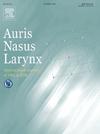Intraoperative symptom-guided plug size selection in sitting position Kobayashi plug surgery for patulous eustachian tube
IF 1.5
4区 医学
Q2 OTORHINOLARYNGOLOGY
引用次数: 0
Abstract
Objective
To evaluate the efficacy and safety of Kobayashi Plug Surgery (KPS) for patulous Eustachian tube (PET) performed under local anesthesia in the sitting position, using intraoperative subjective symptoms to guide plug size selection, and to investigate its effect on revision surgery rates.
Methods
This retrospective study included 61 patients (73 ears) with refractory PET who underwent KPS between December 2023 and June 2025. All procedures were performed under local anesthesia with patients in the sitting position, allowing for real-time assessment of subjective symptoms immediately after plug placement. If symptoms persisted, the plug size was increased intraoperatively. Clinical data, surgical outcomes, plug sizes, and postoperative complications were analyzed. Long-term outcomes were assessed in 29 ears with follow-up exceeding 180 days using PHI-10, Eustachian tube function tests, and revision surgery rates.
Results
Plug placement was successful in 66 of 73 ears (90.4%). Plug size adjustment during initial surgery was performed in 5 ears (7.6%) based on persistent symptoms. Among 29 ears with long-term follow-up (median: 297.5 days), the overall revision surgery rate due to upsizing was 10.3%. However, among the 41 ears that presented with subjective symptoms at the time of surgery, only 1 case (2.4%) required revision surgery during follow-up. PHI-10 scores significantly improved from a median of 30 to 10 (p < 0.001), and sonotubometry sound pressure levels increased from 85 dB to 99 dB (p < 0.005). Tympanic membrane perforation was observed in one ear (preexisting), and ventilation tube placement for otitis media with effusion was required in 4 ears (13.8%).
Conclusion
KPS under local anesthesia in the sitting position allows for intraoperative symptom-based plug size selection, which may help reduce the need for revision surgery, especially in patients with active symptoms at the time of surgery. While the overall revision rate was 10.3%, it was markedly lower (2.4%) among symptomatic cases. Although the findings should be interpreted with caution due to the small sample size and retrospective design, this technique represents a promising approach for improving surgical outcomes in patients with refractory PET.
术中症状引导下坐位塞的大小选择小林塞术治疗扩张性咽鼓管
目的评价局麻坐位下小林塞术(Kobayashi塞术)治疗扩张性咽鼓管(PET)的疗效和安全性,以术中主观症状为指导选择塞的大小,并探讨其对改型手术率的影响。方法回顾性研究包括61例(73耳)难治性PET患者,于2023年12月至2025年6月间行KPS。所有手术均在局部麻醉下进行,患者为坐位,可在置入导管后立即实时评估主观症状。如果症状持续,则术中增加塞的大小。分析临床资料、手术结果、堵头大小和术后并发症。通过pi -10、咽鼓管功能测试和翻修手术率对29只耳朵的长期预后进行评估,随访时间超过180天。结果73耳中66耳植入成功,成功率90.4%。根据持续症状,在初始手术期间对5只耳朵(7.6%)进行耳塞大小调整。在29只长期随访耳中(中位297.5天),因增大而进行翻修手术的总体比例为10.3%。然而,在手术时出现主观症状的41只耳朵中,只有1例(2.4%)在随访期间需要翻修手术。pi -10评分从中位数30分显著提高到10分(p < 0.001),声压级从85 dB提高到99 dB (p < 0.005)。1耳(既往)鼓膜穿孔,4耳(13.8%)因中耳炎积液需放置通气管。结论坐位局麻下kps术中可根据症状选择栓的大小,尤其对于术中症状活跃的患者,可减少翻修手术的需要。虽然总体修正率为10.3%,但在有症状的病例中明显较低(2.4%)。尽管由于样本量小和回顾性设计,研究结果应谨慎解释,但该技术代表了改善难治性PET患者手术结果的有希望的方法。
本文章由计算机程序翻译,如有差异,请以英文原文为准。
求助全文
约1分钟内获得全文
求助全文
来源期刊

Auris Nasus Larynx
医学-耳鼻喉科学
CiteScore
3.40
自引率
5.90%
发文量
169
审稿时长
30 days
期刊介绍:
The international journal Auris Nasus Larynx provides the opportunity for rapid, carefully reviewed publications concerning the fundamental and clinical aspects of otorhinolaryngology and related fields. This includes otology, neurotology, bronchoesophagology, laryngology, rhinology, allergology, head and neck medicine and oncologic surgery, maxillofacial and plastic surgery, audiology, speech science.
Original papers, short communications and original case reports can be submitted. Reviews on recent developments are invited regularly and Letters to the Editor commenting on papers or any aspect of Auris Nasus Larynx are welcomed.
Founded in 1973 and previously published by the Society for Promotion of International Otorhinolaryngology, the journal is now the official English-language journal of the Oto-Rhino-Laryngological Society of Japan, Inc. The aim of its new international Editorial Board is to make Auris Nasus Larynx an international forum for high quality research and clinical sciences.
 求助内容:
求助内容: 应助结果提醒方式:
应助结果提醒方式:


